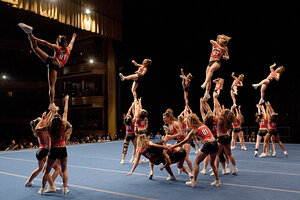Cheerleading doesn't count as a real sport, judge rules
Universities cannot use competitive cheerleading in their efforts to achieve gender balance in athletics and comply with Title IX, a judge ruled Wednesday.

The University of Maryland competes in the 2007 NCA/NDA US Championship held in New York. Competitive cheerleading is not developed enough to be considered a 'genuine' varsity sport, a judge ruled.
Newscom/file
Cheerleading can be athletic and competitive, but it doesn’t count as a sport when universities are counting up male and female athletes to comply with Title IX, a federal gender-equity law.
That was the conclusion in a class action suit on behalf of female athletes at Quinnipiac University in Hamden, Conn.
The school planned to eliminate women’s volleyball – as well as men’s golf and outdoor track – to save money. But it added a competitive cheer squad and counted its 30 female members to show that the percentage of athletes who are female is in proportion to the percentage of students who are female – one way of complying with the law.
US District Judge Stefan Underhill agreed with the volleyball coach, ruling that the school discriminated “by failing to provide equal athletic participation opportunities for women.” Competitive cheerleading “is still too underdeveloped and disorganized to be treated as offering genuine varsity athletic participation,” he concluded.
Has Title IX 'outlived its usefulness'?
Title IX advocates count it as another victory for equal opportunity in sports. Each school’s efforts to meet Title IX have to be judged individually, but they say this ruling sets an important precedent that will influence universities around the country.
“We understand that in these difficult economic times,... schools are looking for ways to tighten their budgets,... but this case sends a clear message that schools cannot cut costs on the backs of women,” says Neena Chaudhry, senior counsel for the National Women’s Law Center in Washington.
Advocates of competitive cheerleading as a sport disagree. It involves gymnastics and tumbling and has a high injury rate, says Kimberly Archie, founder of the National Cheer Safety Foundation in North Hollywood, Calif.
She also disagrees with the decision more broadly, saying that “Title IX has outlived its usefulness.” Ms. Archie argues that women’s interest in sports participation on many campuses simply isn’t as high as men’s, so proportional numbers aren’t needed to ensure equal opportunity.
The 95-page judgment required Quinnipiac to maintain the volleyball team for the coming season and submit a plan within 60 days for how it would comply with Title IX.
Three runners are better than one
It also said female runners on three different teams (indoor, outdoor, and cross-country track) could not be counted more than once. That was one of several ways the school had inflated the number of female athletes or undercounted male athletes, the judge concluded.
“Institutions are sometimes not doing due diligence in representing the actual numbers on the rosters,” and this case sends the message that such manipulation won’t be tolerated, says Shawn Ladda, president of the National Association of Girls and Women in Sport.
A Quinnipiac spokeswoman expressed disappointment in the ruling. “We will continue to press for competitive cheer to become an officially recognized varsity sport in the future,” said Lynn Bushnell, vice president for public affairs, in a written statement. “Consistent with our long-standing plans to expand opportunities in women’s athletics, the university intends to add women’s rugby as a varsity sport beginning in the 2011-2012 academic year.”
Neither the National Collegiate Athletic Association (NCAA) nor the US Department of Education has recognized competitive cheerleading as a sport.
Related:
